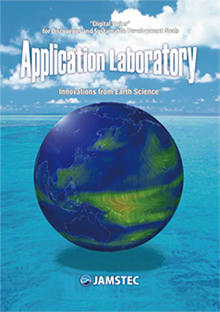APL Column

Toru Miyama
Senior Scientist
Environmental Variability Prediction and Application Research Group
Aircraft debris drifted to Reunion Island in the Indian Ocean
The news made headlines around the world on 30th July.
The wreckage is believed to be a part of the Malaysian Airlines flight MH370 that disappeared over the East Indian Ocean in March 2014. It has been assumed so far that the plane crashed into the east side of the Indian Ocean. Supposing the assumption is correct, we performed a simulation to verify whether it is possible for the aircraft to drift to Reunion Island.
Application Laboratory (APL) is conducting research and development of JCOPE-FGO, an ocean model that can calculate global ocean currents. The model allows us to reproduce ocean currents close to reality, and to make a prediction of up to 2 weeks by incorporating observation values.
(JCOPE Page)
Figure 1 shows the average status of the South Indian Ocean from 8th March 2014, when the aircraft went missing, to 29th July 2015. On average we can see a counterclockwise surface current (*1) in the South Indian Ocean. Given the plane drifted along the circulation, it is highly likely that the debris drifted from the assumed crash site to Reunion Island, although we should take into account complicated factors such as seasonal changes and vortexes (*2).
Our laboratory is using the same computer program to predict and provide commentaries on Kuroshio and Oyashio, ocean streams close to Japan (Kuroshio-Oyashio Watch).

Figure 1: Status of ocean circulation near the sea level in the South Indian Ocean calculated with JCOPE-FGO. It shows estimate values that seem close to reality, obtained by incorporating observation values. The arrows indicate directions and strength of the streams (unit: meter per second). The colors show sea surface height (unit: meter. Darker red means higher sea height), which is the index of water pressure that causes ocean currents.
- *1
- Ocean circulation near the sea level in the Indian Ocean is an ‘anticyclone’ circulation that rotates around high sea height in a counterclockwise direction (note that we use the word anticyclone for water pressure, not atmospheric pressure). Contrary to the north hemisphere, ocean currents circle around high air (water) pressure counterclockwise in the south hemisphere. This ocean circulation is called wind-driven circulation, driven by winds (the trade winds near the equator and from high latitude).
- *2
- This does not mean the assumption of the crash site has been proved, or deny possibility of other potential crash sites.







